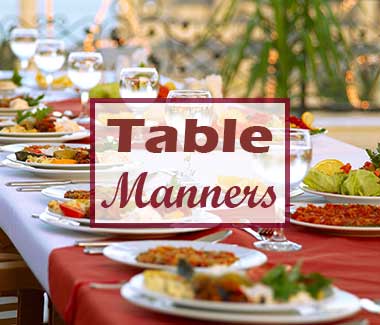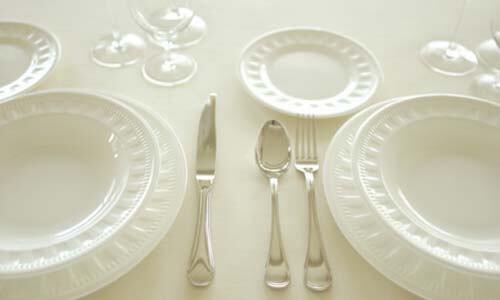Greek Dining Etiquette
international dining etiquette
Dining etiquette for drinking. Wine is drunk at lunch and dinner, but if you are drinking ouzo, be sure to take small sips. The more you drink, the more you will be offered to drink. If you don't want to drink more, leave your glass more than half full.
Dining etiquette for toasts.
Στην υγειά σου!
(to your health)
Table Manners
Dining etiquette for beginning to eat. Do not begin eating until your host invites you to.
Dining etiquette for utensils. Greeks do not switch knives and forks. The knife remains in the right hand and the fork remains in the left. When you're finished with your meal, cross your knife and fork on your plate, with the knife underneath the fork and the tines of the fork facing down.
Dining etiquette for using a napkin. If you place your napkin up on the table or on the plate, most Greeks will also take this to mean that you are finished.
Dining etiquette for your place setting. The fork and spoon above your plate are usually for dessert. If you're unsure of which utensil to use, always start from the outside and work your way in, course by course.
Dining etiquette for eating bread. Bread is usually served without butter and there usually is no bread plate.
Dining etiquette for your hands. When not holding utensils, your hands are expected to be visible above the table. Rest your wrists on top of the table.
Dining etiquette for passing food. Pass all dishes to your left.
Dining etiquette for gravy or sauce. If there is gravy or sauce, you can generally use your bread to soak some of it up.
Dining etiquette for sharing food. Guests can sometimes feel free to eat from or taste the food on each other's plates.
Dining etiquette for seating. The most honored positions are in the middle of the table, at each side, with the most important guest seated immediately to the right of the host (women to the right of the host. and men to the right of the hostess). If there is a hosting couple, one will be seated at each side of the table. More traditional hosts might seat men next to men and women next to women or segregate them completely.
Dining etiquette for order of service. The oldest or most honored guest is served first.
Dining etiquette for restaurants. In informal restaurants, you may be required to share a table. Wait staff may be summoned by making eye contact.
Dining etiquette for talking business. Depending upon how well developed your relationship is with your Greek colleagues, it is generally not the time to make business decisions. Take your cue from your Greek associates.
Dining etiquette for in a home. You will be told where to sit, and there you should remain. Allow the more senior members of your party to enter rooms ahead of you. Do not presume to seat yourself, as the seating arrangement may be predetermined.
Dining etiquette for paying the bill. Usually the one who does the inviting pays the bill, although the guest is expected to make an effort to pay. Sometimes other circumstances determine the payee (such as rank).
Dining etiquette for tipping. A 10 percent tip is usually sufficient for restaurants. Restaurants usually have the 10 percent tip already included on the bill.




